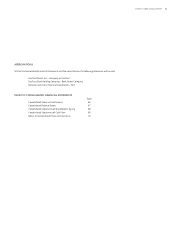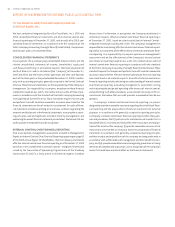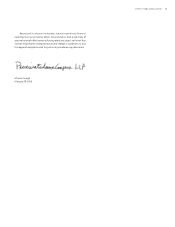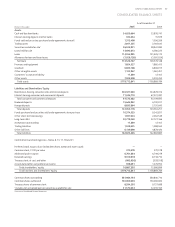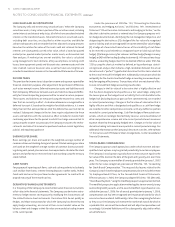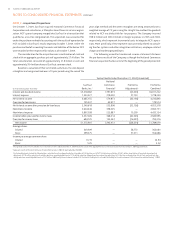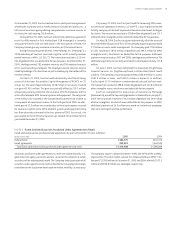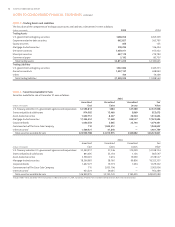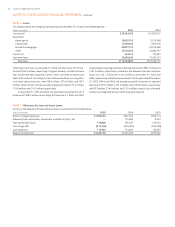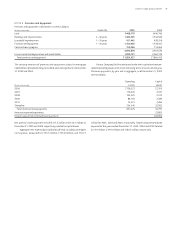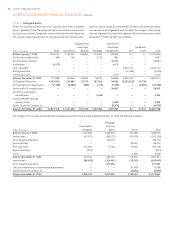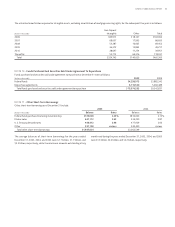SunTrust 2005 Annual Report Download - page 73
Download and view the complete annual report
Please find page 73 of the 2005 SunTrust annual report below. You can navigate through the pages in the report by either clicking on the pages listed below, or by using the keyword search tool below to find specific information within the annual report.SUNTRUST ANNUAL REPORT 71
in the process of collection; (ii) collection of recorded interest or principal is
not anticipated; or (iii) income for the loan is recognized on a cash basis due
to the deterioration in the financial condition of the debtor. Consumer and
residential mortgage loans are typically placed on nonaccrual when pay-
ments have been in default for and days or more, respectively.
When a loan is placed on nonaccrual, unpaid interest is reversed
against interest income. Interest income on nonaccrual loans, if recognized,
is either recorded using the cash basis method of accounting or recognized
at the end of the loan after the principal has been reduced to zero, depend-
ing on the type of loan. If and when borrowers demonstrate the ability to
repay a loan in accordance with the contractual terms of a loan classified
as nonaccrual, the loan may be returned to accrual status. If a nonaccrual
loan is returned to accruing status, the accrued interest at the date the loan
is placed on nonaccrual status, and foregone interest during the nonaccrual
period, are recorded as interest income only after all principal has been col-
lected for commercial loans. For consumer loans and residential mortgage
loans, the accrued interest at the date the loan is placed on nonaccrual
status, and forgone interest during the nonaccrual period, are recorded as
interest income as of the date the loan no longer meets the and day
past due criteria. (See Allowance for Loan and Lease Losses section of this
Note for further discussion of impaired loans.)
Fees and incremental direct costs associated with the loan origination
and pricing process, as well as premiums and discounts, are deferred and
amortized as level yield adjustments over the respective loan terms. Fees
received for providing loan commitments that result in loans are deferred
and then recognized over the term of the loan as an adjustment of the
yield.
ALLOWANCE FOR LOAN AND LEASE LOSSES
The Company’s allowance for loan and lease losses is the amount con-
sidered adequate to absorb probable losses within the portfolio based on
management’s evaluation of the size and current risk characteristics of the
loan portfolio. Such evaluation considers prior loss experience, the risk rat-
ing distribution of the portfolios, the impact of current internal and exter-
nal influences on credit loss and the levels of nonperforming loans. Specific
allowances for loan and lease losses are established for large impaired loans
on an individual basis as required per Statement of Financial Accounting
Standard (“SFAS”) No. , “Accounting by Creditors for Impairment
of a Loan—an amendment of FASB Statements No. and ,” and SFAS
No. , “Accounting by Creditors for Impairment of a Loan-Income
Recognition and Disclosures—an amendment of FASB Statement No.
,” and large impaired leases based on the criteria set forth in SFAS No.
, “Accounting for Contingencies.” The specific allowance established for
these loans and leases is based on a thorough analysis of the most probable
source of repayment, including the present value of the loan’s expected
future cash flows, the loan’s estimated market value, or the estimated fair
value of the underlying collateral. General allowances are established for
loans and leases that can be grouped into pools based on similar character-
istics as described in SFAS No. . In this process, general allowance factors
are based on an analysis of historical charge-off experience and expected
losses given default derived from the Company’s internal risk rating process.
These factors are developed and applied to the portfolio in terms of line
of business and loan type. Adjustments are also made to the allowance for
the pools after an assessment of internal and external influences on credit
quality that have not yet been reflected in the historical loss or risk rating
data. Non-pool-specific allowances relate to inherent losses that are not
otherwise evaluated in the first two elements. The qualitative factors asso-
ciated with the non-pool-specific allowances are subjective and require a
high degree of management judgement. These factors include the inherent
imprecisions in mathematical models and credit quality statistics, recent
economic uncertainty, losses incurred from recent events, and lagging or
incomplete data.
PREMISES AND EQUIPMENT
Premises and equipment are carried at cost less accumulated depreciation
and amortization. Depreciation is calculated primarily using the straight-
line method over the assets’ estimated useful lives. Certain leases are capi-
talized as assets for financial reporting purposes. Such capitalized assets
are amortized, using the straight-line method, over the terms of the leases.
Maintenance and repairs are charged to expense, and improvements are
capitalized.
GOODWILL AND OTHER INTANGIBLE ASSETS
Goodwill represents the excess of purchase price over the fair value of iden-
tifiable net assets of acquired companies. Under the provisions of SFAS No.
, “Goodwill and Other Intangible Assets,” goodwill is not amortized and
instead is subject to impairment testing on an annual basis, or more often if
events or circumstances indicate that there may be impairment. The good-
will impairment test is performed in two phases. The first phase is used to
identify potential impairment and the second phase, if required, identifies
the amount of impairment by comparing the carrying amount of goodwill
to its implied fair value.
Identified intangible assets that have a finite life are amortized over
their useful lives and are evaluated for impairment whenever events or
changes in circumstances indicate the carrying amount of the assets may
not be recoverable.
MORTGAGE SERVICING RIGHTS “MSRs”
The Company recognizes as assets the rights to service mortgage loans for
others whether the servicing rights are acquired through purchase or loan
origination. Purchased MSRs are capitalized at cost. For loans originated
and sold where the servicing rights have been retained, the Company allo-
cates the cost of the loan and the servicing rights based on their relative
fair market values at the time of sale of the underlying mortgage loan. Fair
value is determined through a review of valuation assumptions that are
supported by market and economic data collected from various outside
sources. The carrying value of MSRs is maintained on the balance sheet in
intangible assets.
There are two components to the amortization expense that the
Company records on MSRs. First, the Company fully amortizes the remaining
balance of all MSR assets for loans paid in full in recognition of the termina-
tion of future cash flow streams. Second, amortization on the surviving MSR
assets is recorded based on the current cash flows as estimated by future
net servicing income. The current cash flows are calculated and updated
monthly by applying market-driven assumptions, such as interest rate and
prepayment speed assumptions. Impairment for MSRs is determined based
on the fair value of the rights, stratified according to interest rate and type
of related loan. Impairment, if any, is recognized through a valuation allow-
ance with a corresponding charge recorded in the Consolidated Statements
of Income.




